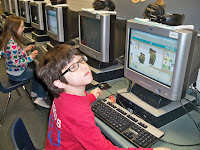Today we welcomed Duaa, Elsie and Patty. They were enthusiastic and maybe a bit nervous at the start of our day. By the end, they seemed to have settled right in to our group. I know they will be great additions to our class!
After getting to know our new friends, we reviewed on the white board how to locate our endangered animals site,
www.arkive.org and how to search for a specific species. Today, was our "highly anticipated" day to choose our research animal. After one final look at our endangered list, the students settled on their choices. This group is studying a variety of species including yellow crested cockatoo, chimpanzee, Asian buffalo, yellow headed parrot, Bengal tiger and several others. Ask you child about their choice and what inspired their decision.
The students were introduced to/reviewed how to search for a library book by author, title, subject or series in our district online catalog. Because our species are so specific, many students had to refine their search to include all or our district's elementary school libraries. It is difficult skill to learn to broaden a search and it requires the students to be flexible in their thinking and persistent in their search. Hopefully the books we are ordering will be helpful in our research. Next week, we will go to the district online resources to find a Searchasaurus article on our animal. It will be one of our main resources.
I am not concerned about finding sufficient information. The animals I offered as choices were ones for which I know we have information. As this is their very first, in depth research project, I want them to be challenged, but I also want them to be successful. It is my goal for each student to have a bibliography that includes at least one book, traditional encyclopedia, online article, online encyclopedia and possibly a magazine article. This will give them the opportunity to learn to cite a variety of sources too.
Next week, for most of the students is still pretty fun. We will be focused on gathering sources. The following two to three SAGE days will be pretty challenging and fairly taxing. My usual opening statement for the day will be, "You need to be prepared to work really hard today. You are going to feel confusion and frustration and you will get tired of writing, but I promise you, if you dig in and persevere through the research portion of our study, I will make it worth your while with our projects." Very few adults, let alone students, enjoy the note-taking, knowledge-gathering portion of a research study. In general, these will be the whiniest weeks in my classroom, (LOL) but at the same time, they will contain the work for which the students are the most proud. With that pride comes confidence in their abilities and in himself/herself. As you talk to your child after their SAGE day, ask them what they have learned about their animal, encourage them to persist in their note-taking and most importantly, praise them for their efforts. One great outcome you will see is they sleep well after a long day of work!
After lunch and recess, the students worked on their math problem solving skills in the TOPS Math program, (our individualized math problem solving program.)
Next, I introduced the students to a visual perceptions game called SET. In this game, they have to find sets of three cards where all of the cards attributes are either all the same or all different. It is a very "tight thinking" activity.
We ended our day with Spanish instruction by Senora Gates. Today the students learned practiced their numbers from 1-40.
I enjoyed our day and I hope your child did too!
























